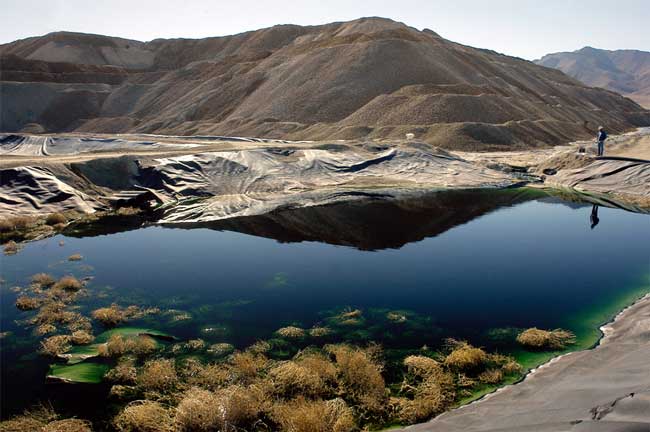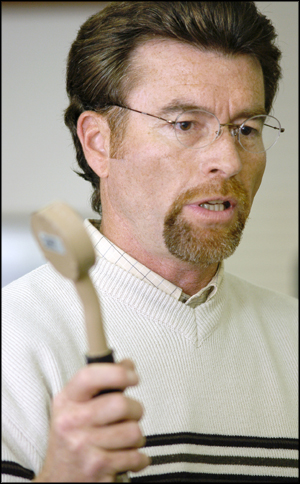|
Lack
of information concerns Yerington residents
Locals
worry about mine pollution
By Kristin Larsen
Sparks Tribune
Published January 5, 2005
Updated
9-8-2006
While agencies
evaluate possible workers’ safety risks at the Yerington mine,
some residents wonder if radioactive contaminates could be infiltrating
their well water or blowing into their community during dust storms.
How
much radiation is too much?
The
average dose nationwide is approximately 360 millirems per
year.
The
EPA standard for radiation from man-made sources for the
public is 15 millirems per year.
The
OSHA and Nuclear Regulatory Commission standard for workers
appropriately trained and equipped is 5,000 millirems per
year.
Atlantic
Richfield’s standard for workers on the Yerington site
is 500 millirems per year. That is 10 percent of the Occupational
Health and Safety Administration (OSHA) standard.
|
According
to preliminary evaluations and former mine owner Atlantic Richfield's
Worker Health and Safety Plan, contractors can safely work in most
parts of the mine, but there are different safety standards for
residents. Little has been done to evaluate those risks.
"The problem with this site is that we don't have enough information,"
said Jim Sickles, Environmental Protection Agency remedial project
manager. "In a year or two we should be a lot smarter."
Sickles said agencies have different standards because they are
evaluating different risks and some are more conservative than others.
Agencies like OSHA look at what is an acceptable momentary dosage,
whereas the EPA evaluates health risks over a 30-year period.
Sickles compares these different processes to evaluating the health
risks of a person who walks through a smoke-filled room verses someone
who lives in a smoke-filled house. The acceptable annual dosage
for a person living in a smoke-filled house should be much lower
because it is a long-term risk that could accumulate in a person’s
body.
Yerington
resident and former mine worker Brian Gibbs said he would appreciate
more information about possible health risks to residents and former
workers.
"I
think people deserve to know the truth about the site, especially
those who own property," Gibbs said. "The town needs to
know the truth for the future of the community."
But Gibbs
said the residents of Yerington have mixed feelings about finding
contamination on their property and some might prefer not to know
because they are afraid of property values plummeting.
There is a large community surrounding the site. According to an
NDEP document from 2000, "The local groundwater is the sole
source of drinking water for the approximately 3,000 people living
within four miles of the site."
The document also said the mine was repeatedly cited in 1983 for
polluting the groundwater and that drainage ditches north of the
site were being"degraded, possibly by the groundwater seeps
emanating from the mine." The groundwater on the mine site
is still contaminated but pumps designed to keep the groundwater
on the site are still in operation.
Well results from September 2004 show all the domestic wells on
the Yerington Paiute Campbell Reservation are eligible for free
water due to uranium contamination. This is an increase from previous
months.
However, there has been no direct link made between the mine and
the wells' high content of uranium.
To investigate these issues Peggy Pauly and others are organizing
the Community Action Group for Yerington.
Pauly said they are attempting to ensure the safety of the community
by fighting for proper testing.
"We have been called chicken-littles," Peggy Pauly said.
"Prove to me the sky is not falling. Some people are acting
like ostriches."
To date
Atlantic Richfield, owned by British Petroleum, has installed six
air monitors, conducted quarterly water samples, capped 80 percent
of mining tailing to prevent it blowing away, said Dan Ferriter,
ARCO environmental business manager.
British
Petroleum has spent $6 million in cleanup costs and evaluation for
the site since they became a potentially responsible party in 2000,
said B.P. spokesman Don Cummings. In spite of the current cleanup
and evaluation efforts, some residents said they are not communicating
their discoveries effectively to those living in the community.
"They have to do a lot more," Don Shepman said. "They
need to be honest with us and that's a thing they haven't been.
They need to tell us if there is a threat to our health and where
it is."
Copyright © 2005
Daily Sparks Tribune. Used by permission.
BACK
TO ANACONDA/YERINGTON INDEX
Yerington
residents have contamination concerns
By Kristin Larsen
Sparks Tribune
Dec. 12, 2004
Updated
9-8-2006
Yerington Paiutes living
on the reservation may have been surprised to discover on Friday
that the mining company Atlantic Richfield will offer them bottled
water to drink as a safety precaution.
|
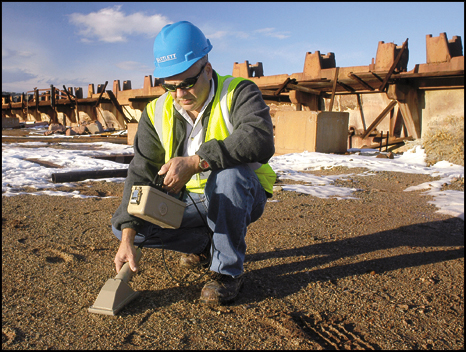
—Tribune/Debra
Reid
|
|
Douglas McBride measures radiation near vats used to extract
copper at the former Anaconda mine. McBride is developing
a safety program for workers sampling the mine's soil and
groundwater. Residents near the mine worry contamination
has endangered their health.
|
Well results from September
show the entire Yerington Paiute Campbell Reservation is eligible
for free water due to uranium contamination. This is an increase
from previous months.
Uranium in the wells at levels greater than 25 parts per billion
has prompted the Nevada Department of Environmental Protection
to direct ARCO to supply water to interested residents.
Some residents are concerned that contaminates like the uranium
found in the wells are escaping from a nearby mine known to be
radioactive. Radioactivity is so high in some parts of the mine
that a worker could have received a dose of radiation in one eight-hour
shift that surpasses the EPA's standard of a yearly dosage for
a person without protective gear.
On Wednesday, 56 residents gathered to discuss the mine's contaminates
and possible health risks. Former mining employee Pamela Bengochia-Muñoz
is concerned that her poor health is work-related.
"I'm not in good
health," she said. "That's why I'm at this meeting."
|
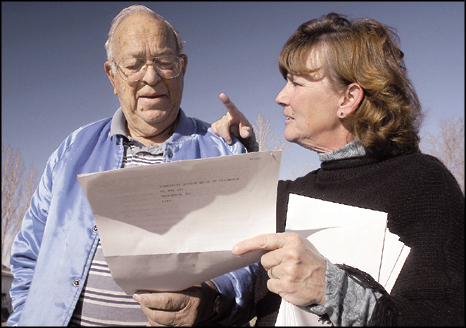
—Tribune/Debra
Reid
|
Peggy
Pauley, right, asks neighbor William Wubbenhorst to fill
out a health survey she's circulating throughout the community.
Wubbenhorst's well water has an unsafe level of uranium,
so he and his wife must use bottled water provided by
the Atlantic Richfield Company.
Whistleblower
fuels neighbors' fears near polluted Nevada mine (Associated
Press 11-25-2004)
|
She worked for three
different mining companies on the Yerington site since 1976 and
whether she was cleaning the sulfuric acid vats, the spills, or
working in the iron launder her uniform has always been the same:
regular clothes, steal-toed boots, gloves and a hard hat.
It wasn't enough to protect her from the burns she would get on
her eyes and skin or from the red dust she inhaled. She wondered
if it has caused her intestinal polyps, liver failure and the
almost complete shut down of her kidneys.
"I want to be told the truth - if I was working with dangerous
chemicals," Bengochia-Muñoz said.
Dayna Anglin
is more concerned about the possible contaminates currently infiltrating
their community. Her well tested three times above the standard.
NDEP told her not to brush her teeth with her water. If uranium
is consumed in high doses it can cause congestive kidney failure
and she said she worries for her family and two children.
Dietrick McGinnis, the Yerington Paiute Tribe's environmental
attorney said, "We’ve assessed this from the technical
side for years. I share you’re frustration – thank God
I don’t share your water."
Until now little has
been done to discover if contaminates from the mine have reached
into the community beyond testing private wells. Only recently
have the locations of off-site monitoring wells been agreed on
by the three agencies involved in the clean-up, the NDEP, the
Environmental Protection Agency and the Bureau of Land Management.
To investigate these issues Peggy Pauly and others are organizing
a Community Action Group for Yerington.
They are pushing for two courses action to evaluate the dangers
to those who have lived around the mine and worked on it.
- First, they are asking Federal
agencies to conduct a aerial survey for radiation on and off the
site.
- Second, they are asking interested
residents to fill out a health survey and be screened for exposure
to radioactive materials.
If contaminates are found in the community, there will be a larger
area of clean-up and potential compensation to those affected.
During an aerial survey a sodium iodide detector hangs from a
helicopter 150 feet above the ground. It flies in a grid formation
that will be calculated and recorded into a computer. This same
method is used to find dirty bombs.
The agencies regulating the site clean had initially proposed
to conduct an aerial survey, but decided to instead conduct on-site
soil testing.
Earle Dixon, a recently-fired
BLM worker, claims that he was wrongfully terminated for blowing
the whistle on inadequate testing.
Dixon said the survey
could help to answer many questions about the spread of contamination.
Marc Picker, an attorney for the group that is compiling health
information, said agencies like BLM, NDEP and EPA are not set
up to evaluate health problems in the community that may be a
result of contaminates from the mine.
That’s why he
recommends that those who worked on the mine or lived near it
get tested for high levels of chemicals like thorium or radium,
which stay in the body.
"Federal agencies are designed to clean up water and land,
but they don’t solve health problems," Picker said.
"None of them
will say here’s $1,000 to get tested or for your medical
bills. I guarantee Atlantic Richfield Company, BLM and the state
start listening when you start suing them."
Picker said thorium, which was found on the site, has been linked
to joint pain and bone pain.
Radium, also on the
site, has been linked to thyroid cancer, certain types of breast
cancer, chronic fatigue and other symptoms.
Unless residents are tested, there is no way to determine a connection
between the chemicals and health problems.
"We’re at the very beginning," Picker said. "We’re
not guaranteeing results or a lawsuit, but we can help them investigate
avenues for compensation."
One of the group's goals has already been met. The state has requested
that the EPA be named the lead agency in the clean-up of the site.
This was also the hope
of the Yerington Paiute Tribe, the City of Yerington, and Lyon
County.
Previously, the BLM,
EPA and NDEP had to agree to approve work plans and NDEP organized
the effort. NDEP's website refers the themselves as the lead agency.
Wayne Garcia, the Yerington
Paiute tribal chairman, said, "This is a giant step toward
dealing with the issues of community health for many generations
to come. It's nice to get a Christmas present early."
Copyright © 2004
Daily Sparks Tribune. Used by permission.
BACK TO ANACONDA/YERINGTON
INDEX
Yerington
woman starts petition drive
By Kristin Larsen
Sparks Tribune
Published Sept. 21, 2004
"We’re not
allowed to go under our house without full HAZMAT suits on,"
said Misty Stevens, a resident on the Yerington Paiute’s
tribal land. Radon above Environmental Protection Agency standards
was found in 45 percent of buildings tested on Yerington's Campbell
Reservation and her house was one of them.
|
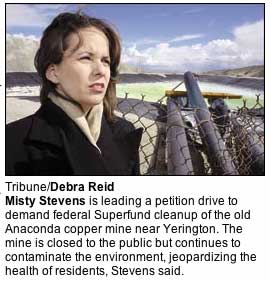
|
|
CAPTIONS
TO ADDITIONAL PHOTOS NOT DISPLAYED WITH THIS STORY
Photo courtesy of Misty Stevens —
This is one of the evaporation ponds on the site where chemical
solutions used to break down metals have accumulated.
Photo courtesy of Misty Stevens —
This is the entrance to the room featured above. Parts of
the stairs and railing have been disolved by the solution.
Photo courtesy of Misty Stevens —
She says this room has been sealed by NDEP for the safety
of the public, but the room continues to hold chemicals
that have eaten away at the stairs and fixtures in the room.
She speculates the floor may be gone or decomposed. Since
the room has been sealed there has been no testing. Stevens
asks how do they know it's not getting into the ground water?
|
"The EPA said
it’s safe to live there, but I don’t buy that,"
Stevens said.
EPA Remedial Project
Manager Jim Sickles said foundations of many houses on the Campbell
Reservation were constructed from mine tailings from a nearby
mine. The soil around Yerington is naturally rich in uranium and
chemical processes miningcompanies use can condense other radioactive
materials into higher concentrations.
"I’ve got elevated levels of radon in my house and a
new baby and I can’t get an answer from any of the agencies
of what they’re going to do to help us," Stevens said.
That's why she and her husband have decided to start a petition
asking for the site to become a Superfund site instead of continuing
under state control.
The mine, which sits less than a mile from some homes, has qualified
for Superfund status. Radioactivity is so high in some parts of
the mine that a worker could have received a dose of radiation
in one 8-hour shift that surpasses the EPA's standard of a yearly
dosage.
But Governor Kenny Guinn and local county commissioners are against
the listing because they are afraid of a Superfund stigma and
lower property values.
Stevens already sent 200 signatures to Governor Guinn but over
the weekend she got 150 more. She said she'll continue to send
them until Guinn changes his mind.
Of the 358 people she's asked she said only 8 haven't signed.
She said the two main responses she has gotten from those who
sign the petition have been, "Nothing is being done."
or "What cleanup?"
"I think the petition signatures show that the County Commissioners
stance doesn’t represent what the people want," Stevens
said. "The people want a real clean-up, federal dollars and
jobs. A Superfund clean-up creates jobs."
But others have different opinions of the site clean-up.
Lyon county commission candidate Don Tibbals and his wife Joy
own the Weed Heights Development, with 231 homes, located just
uphill from the mine. The Tibbals said they have no health problems
and their water always tests clean.
The Tibbals believe any contamination should be cleaned up but
Superfund status for the mine would be unnecessary and a waste
of taxpayers' money.
Great Basin Mine Watch Program Associate Christine Whiteside said
GBMW just wants to see the site cleaned up and have no preference
for how it happens. She said she believes most residents are against
a Superfund listing, but there seem to be many misconceptions
about what having it listed would mean.
"I think there’s a lot of misunderstanding about what
Superfund is," Whiteside said. "I think it would help
to clear up the misunderstandings that swirl around Superfund."
One thing everyone seems to agree on is that the clean-up is taking
a long time.
"The state has been dragging its feet," Whiteside said.
"We’re unsure if it’s because the state lacks the
authority to force ARCO to clean up the site, or if they just
lack the manpower and money for an effective clean-up."
The longer it takes to clean up the site the more opportunity
contaminates have to spread.
Some private wells contain levels of uranium above drinking-water
standards, according to the Nevada Department of Environmental
Protection. The uranium found in private wells above drinking-water
standards has not been linked to the mine, said BLM and NDEP officials,
but the former Anaconda mine owners estimated in 1976 that the
Yerington mine could produce as much as 50,000 pounds of uranium
oxide annually.
Some residents have been advised not to brush their teeth with
the water that comes out of their faucets. NDEP supplies bottled
water to those who test above a certain amount but not enough
to supply water to crops or livestock.
County Commissioners have proposed connecting the city's water
line to the houses but many homeowners can't afford metered water.
Stevens said she is outraged that so little is being done to look
out for citizens’ well-being.
"Let’s round up all the Indians, put them on a little
plot of land, poison their water and offer to sell them good water,"
Stevens said.
Stevens would like to form a community action group. She asked
the EPA for funding in the form of a technical assistance grant,
which would allow them to hire their own technical advisor that
is not employed by any of the agencies, but was turned down because
the site was not a Superfund. The EPA said they would donate an
employee’s time to help with assessing the site but Stevens
believes the employee might be unfairly influenced by their connection
to the EPA.
She said the NDEP has been negligent in handling the site. She
has pictures of underground tunnels that have filled up with chemical
solutions the mine used to process copper from the soil. Those
underground rooms have had fixtures, railings and stairs eaten
away by chemical processes.
Stevens said NDEP has done nothing to make sure it is not leaking
into the ground. Instead they have put a hatch on the room to
prevent people from entering the room for their safety. But the
result is that no one has tested the substance in the room or
ensured that it is not contaminating the ground water.
Stevens said she is demanding a change in the site’s handling
because these problems have not been addressed.
"These agencies should be ashamed of themselves," Stevens
said.
Copyright © 2004
Daily Sparks Tribune. Used by permission.
BACK TO ANACONDA/YERINGTON
INDEX
Reid: ARCO should pay for miners’
health care
by Kristin Larsen
Sparks Tribune
Published 8-20-04
Yerington miners exposed
to radioactive materials should have their medical bills paid
by the mining company responsible for cleanup, Senator Harry Reid
said Wednesday.
|
CAPTION
TO PHOTOS NOT DISPLAYED WITH THIS STORY
In the highly
radioactive process area, the leach pond contains the remains
of a process used to extract copper from Yerington soil.
The sulfuric acid used to dissolve metals and break down
minerals has drained from the leach pond into a nearby basement
and eaten away the base of a handrail. Photos were taken
in 2002. Photos courtesy of B. Dietrick McGinnis.
|
Radioactivity is so
high in some parts of the mine that a worker could have received
a dose of radiation in one 8-hour shift that surpasses the EPA’s
standard of a yearly dosage for those without protective gear.
The workers were not informed of the presence of radioactive material
and were not protected against it even though documents from 1979
claim "radiological contamination" had become a problem
in areas of the site.
"Health care should be included as part of ARCO’s responsibility
for the cleanup," Reid told the Sparks Tribune. "ARCO
should identify and notify workers who may have been endangered.
They should be screened for resulting illnesses and compensated
for their health problems."
Cancer has become a concern as documents from Nevada's Center
for Health Data and Research reveal a higher incidence of lung
and bronchus cancer in Mason Valley — the area surrounding
Yerington — than the national average.
Yerington averages 91.7 cases of lung or bronchus cancer for every
100,000 individuals according to Health Department findings from
1996-2000. The national average is 62.8 cases for every 100,000.
Elevated rates of cancer
could result from an environmental cause, health officials say.
Reid said not enough progress had been made on the site in the
four years that cleanup has been a priority. Reid advocated that
it should become a Superfund site. The Yerington Paiutes agree.
"The Nevada Department of Environmental Protection has no
obligations to the tribe unlike federal agencies like the Environmental
Protection Agency and BLM," said Johanna Emm, a water quality
coordinator who lives a quarter mile from the mine’s pit
lake. "That’s why we think (a Superfund designation)
would better protect tribal interests."
She said the federal agencies had been more responsive to the
tribe’s concerns. In 1999 the tribe asked the EPA to investigate
the site and in 2000 the EPA said the site was eligible for Superfund
status. The tribe first asked the agencies for an assessment of
radioactive material onsite in December 2001 and asked eight more
times before receiving a limited assessment in 2003 from NDEP,
said Tribal Chairman Wayne Garcia.
Instead of listing the site, the NDEP coordinates the cleanup
efforts of BLM and EPA according to an agreement. Stakeholders
in the site can only make suggestions. All parties agree progress
has been slow, but disagree about the cause of the delay.
"The public perception in newspapers is that ARCO (the mine
owner) drags its feet, but really the delay is a result of the
process (of coordinating cleanup efforts)," said Chuck Zimmerman,
a hydrogeologist with NDEP.
"I think we’d disagree with that," said EPA Remedial
Project Manager Jim Sickles.
After four years of analysis, many of the site’s potential
health risks remain unassessed. Project directors in all agencies
say they don’t know if radioactive materials are escaping
the site in dust storms because it’s never been measured.
Some private wells contain levels of uranium above EPA drinking-water
standards but the connection to the mine is uncertain. The uncertainty
hasn't lessened locals' concerns.
Dayna Anglin has been advised by NDEP not to brush her teeth with
the water that comes out of her faucets. Cooking pasta or watering
her vegetable garden with it is out of the question.
She is a Yerington resident whose well tested three times above
EPA uranium water standards. NDEP gives bottled water to homeowners
whose wells are close to violating that standard.
"I'm a diabetic and I can't drink the water because my kidneys
could shut down," Anglin said.
If uranium is consumed in high doses, it can cause congestive
kidney failure.
Anglin is concerned for her two children, but she relies on the
water that comes from her well for showering and her livestock.
The amount of uranium
found in her well would seem to be above the natural level found
in the area, and the former Anaconda mine owners estimated in
1976 that the Yerington mine could produce as much as 50,000 pounds
of uranium oxide annually. Ground water from the mine generally
flows north toward her home, yet a link has not been established
between the mine and the high levels of uranium found in homeowners'
wells.
Those present at the presentation of the new BLM Health and Safety
plan raised questions about the kind of data collected.
"With the repeated data collection you're doing, I think
there's a limit to what you can learn from that method,"
BLM Project Manager Earle Dixon said to Dan Ferriter representing
ARCO.
Ferriter said he agreed with Dixon, but the company was going
to continue its quarterly samplings because that was the agreement.
Yerington residents have differing opinions about the mine. Some
are extremely concerned, while others say the mine is the only
reason the town of Yerington exists. Most are in the middle and
are either unconcerned or uninterested.
Dick Roberson, a Yerington realtor, said only one person in the
last six months canceled her escrow on a house because of news
about the mine. The other 100 customers he's sold to in that time
haven’t been bothered by it.
"To be honest I can’t keep up with the real-estate sales,"
he said.
Copyright © 2004
Daily Sparks Tribune. Used by permission.
BACK TO ANACONDA/YERINGTON
INDEX
Potential cancer cluster
in Yerington
by Kristin Larsen
Sparks Tribune
Published 7-27-04
Residents of Yerington
have a higher incidence of lung and bronchus cancer than the national
average according to Nevada's Center for Health Data and Research.
|
CAPTION
TO PHOTO NOT DISPLAYED WITH THIS STORY
Residents of
Weed Heights live next to copper ore tailings at the former
Anaconda Mine. The community was built by Anaconda to house
hundreds of employees.
|
Elevated rates of cancer
could result from an environmental cause, health officials say.
Yerington, 55 miles
southeast of Reno, seems to have no shortage of possible suspects:
* Radon above Environmental Protection
Agency standards was found in 45 percent of buildings tested on
Yerington's Campbell Reservation. Radon is a radioactive gas and
the second leading cause of lung cancer nationwide.
* Elevated levels of radioactive
materials were discovered on a nearby mine according to the Bureau
of Land Management.
* Some private wells contain levels
of uranium above drinking-water standards according to the Nevada
Department of Environmental Protection.
Statisticians aren't the only ones who noticed an abnormally high
rate of cancer. Robert Boyce, Tribal Manager of the Yerington
Paiutes, said the number of cancer diagnoses in his community
disturbed him even before the state's findings.
"It just seems like every time we turn around, we're encountering
somebody that has emphysema, or some type of cancer," Boyce
said. "We've had what I think is an above normal incidence
of people dying of cancer out there."
Yerington averages 91.7 cases of lung or bronchus cancer for every
100,000 individuals Health Department findings from 1996-2000
indicated. The national average is 62.8 cases for every 100,000.
Dr. Wei Yang, Director of Health Center Data and Research, cautions
that cancer epidemics can be harder to spot in small towns like
Yerington because the statistical certainty is less, but even
with Yerington's population of 2,883 factored in the occurrence
of cancer is above average.
But no causes have been linked to the cancer cases. EPA studies
indicate that nearly one in 15 homes in America has a high level
of indoor radon, but tribal officials wonder what has caused nearly
half of reservation homes to test at a dangerous level. It could
be a matter of location and building materials.
EPA Remedial Project Manger Jim Sickles said foundations of many
houses on the Campbell Reservation were constructed from mine
tailings. The soil around Yerington is naturally rich in uranium,
and chemical processes mining companies use can condense uranium
and other radioactive materials into higher concentrations.
As Shannon Berumen, the Yerington Paiute Tribe radon program coordinator
said, "Uranium is naturally occurring in this area, but the
higher the concentration of uranium the higher the concentration
of radon."
Radon is not the only cancer-causing agent in close proximity.
A 3,500-acre mine sits less than a mile from some homes and has
tested positive for thorium and radium, elements that can glow
in the dark and have been linked with causing a variety of cancers.
Radioactive material has been found in one area on the site 31
times above EPA clean-up standards while other areas average much
lower.
People can be exposed to them through inhalation and consumption
so dust blowing off the site is a concern to locals.
"There are areas on the mine that are obvious sources of
fugitive dust," Art Gravenstein with NDEP said. "A Yerington
work group is working on a temporary cap for the site while it's
being studied."
BLM and NDEP officials say they don't believe contaminates are
getting off the site, but currently there is no air monitoring
at the site.
"We have not had any information to lead us to believe that
it is escaping offsite," said Bob Abbey, Nevada director
of the BLM.
The uranium found in private wells above drinking-water standards
has not been linked to the mine said BLM and NDEP officials, but
the former Anaconda mine owners estimated in 1976 that the Yerington
mine could produce as much as 50,000 pounds of uranium oxide annually.
The highest level of contamination in a private well was 108 parts
per billion and nine other wells tested at or above the EPA standard
of 30 ppb. The Nevada Division of Environmental Protection has
tested the wells of all homeowners in the area who asked for it
and offered free bottled water to those who test above 24 ppb
of uranium.
Residents of the area and the Yerington Paiutes hope the site
is cleaned up sooner rather than later.
"The (Tribal) Chairman and I have the responsibility to look
out for our people," Boyce said. "And we're exploring
every option we can to see if there's not some way
to speed the process up."
Copyright © 2004
Daily Sparks Tribune. Used by permission.
BACK TO ANACONDA/YERINGTON
INDEX
-30-
|

![]()

![]()
 Campaign '98-2K
Campaign '98-2K![]()

